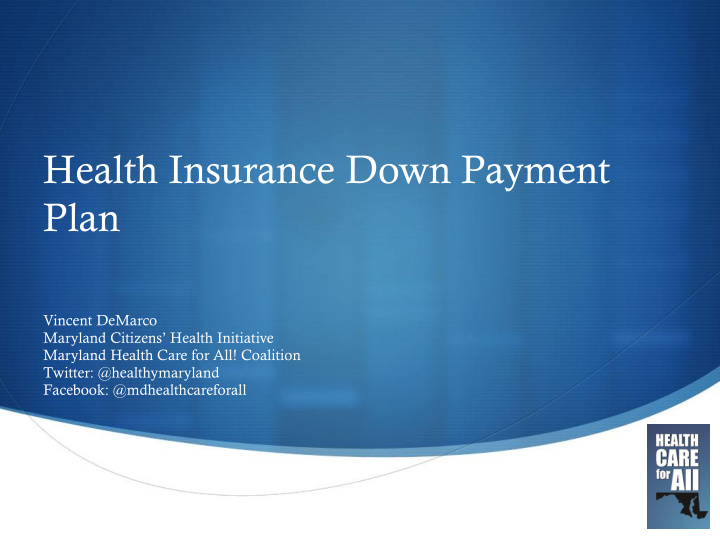



Health Insurance Down Payment Plan Vincent DeMarco Maryland Citizens’ Health Initiative Maryland Health Care for All! Coalition Twitter: @healthymaryland Facebook: @mdhealthcareforall S
The Problem Federal tax bill ended federal enforcement of the individual market, effective: Coverage beginning January 2019 Tax filing in 2020 Without enforcement: Premiums in Maryland’s individual market rise by 16% 69,000 additional uninsured Marylanders: 16,000 fewer people with Medicaid and CHIP 10,000 fewer people with employer-sponsored insurance 43,000 fewer people with individual-market coverage
Health Insurance Down Payment Plan At tax time, Marylanders would be asked if they had quality health coverage in the past year. If they answer no, they have a choice: either pay a penalty to the state or instead use that money to purchase quality, affordable healthcare. Additional exemptions from the personal-responsibility requirement, recognizing Religious convictions that prohibit health-care use The tight budgets of low-wage, working families Enrollment incentives and auto-enrollment replaces mandate penalties, whenever possible If tax return data shows Medicaid eligibility, enroll the uninsured into Medicaid Let consumers convert penalty payments into “down - payments,” to help buy insurance
Benefits of the Proposal Experts predict: About 50,000 Marylanders could enroll in Medicaid who file tax returns but have not yet signed up for coverage. About 78,000 Marylanders could purchase coverage for no more than the penalty combined with federal subsidies. Young and healthy residents would purchase coverage, stabilizing the individual market and lowering premiums.
Benefits Estimated number of Maryland uninsured, Newly covered currently and after implementation of down- payment plan (thousands) S 14,300 children with Medicaid/CHIP 371.5 78.5 S 36,100 adults with Medicaid/CHIP 37.0 241.4 Children and adults >400% FPL 78,700 adults with S Children <400% FPL exchange coverage 78.5 160.2 Adults 139-400% FPL 21.7 Adults < 138% FPL 81.6 95.8 59.7 Current uninsured (2016) Uninsured after potential auto- enrollment Source : Families USA analysis of 2016 ACS data and 2019 MHBE premiums. Notes: “FPL”= federal poverty level. 5
Public Support
Public Support
Prescription Drug Affordability S
Recent Rx Success • Banned “Gag Rules” on Pharmacists • Anti-price gouging measure • **Granted the Attorney General the authority to hold pharmaceutical corporations accountable for “unconscionable” increases in the prices of generic or off - patent drugs • Has been ruled unconstitutional but AG is appealing to the Supreme Court
The Problem Marylanders across the state are struggling to afford the prescription drugs they need, often having to choose between their medication and other necessities, like rent and groceries. High costs can prevent Maryland patients from accessing the prescription drugs they need, cause significant affordability issues for the state, and threaten public health. It is critical that the Maryland General Assembly take action to help ensure that all Marylanders have access to affordable medications, because drugs don’t work if people can’t afford them.
Effect on Public Health
Proposal: Create a Prescription Drug Affordability Board Board would be composed of five members (plus a Stakeholder Council and staffing support) Would establish payment rates for expensive drugs that create significant affordability problems Would examine the entire drug supply chain
The Board would review prescription drugs that meet these criteria: New brand name prescription drugs which enter the market at $30,000 or more per year or course of treatment; Existing brand name medications which increase in price by $3,000 or more per year or course of treatment; Generic medications which increase in price by $300 or more per year or course of treatment; and Any prescription drug that creates affordability challenges to the Maryland health care system, including patients.
Public Support
Public Support
Bipartisanship saved Md.'s Obamacare exchange for now; here's what we need to do next “There are several steps state leaders can take … Maryland needs to enact its own version of the individual mandate, as Massachusetts has. That policy would compliment the reinsurance pool by bringing more customers into the system and driving down rates. Properly structured, it could serve to decrease the ranks of the uninsured rather than generate revenue for the government. Third, the state must look for ways to reduce the level of overall health care costs. Maryland is an innovator in that regard, thanks to our unique system of hospital rate-setting that was expanded under the Hogan administration to cover physician payments and other elements of health care spending. Health care advocates are pushing for candidates to support the creation of a prescription drug affordability board, which would build on Maryland’s hospital rate -setting experience to control runaway drug costs.”
Thank you! Vincent DeMarco demarco@mdinitiative.org (410) 235-9000 Maryland Citizens’ Health Initiative Health Care for All! 2600 St. Paul Street Baltimore, MD 21218
Recommend
More recommend